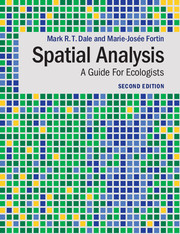Crossref Citations
This Book has been
cited by the following publications. This list is generated based on data provided by Crossref.
Balkenhol, Niko
and
Fortin, Marie‐Josée
2015.
Landscape Genetics.
p.
58.
Miller, Jennifer R. B.
2015.
Mapping attack hotspots to mitigate human–carnivore conflict: approaches and applications of spatial predation risk modeling.
Biodiversity and Conservation,
Vol. 24,
Issue. 12,
p.
2887.
Lecours, V
Devillers, R
Schneider, DC
Lucieer, VL
Brown, CJ
and
Edinger, EN
2015.
Spatial scale and geographic context in benthic habitat mapping: review and future directions.
Marine Ecology Progress Series,
Vol. 535,
Issue. ,
p.
259.
Fortin, Marie-Josée
2015.
Encyclopedia of GIS.
p.
1.
Shi, Wei
Xia, Jun
and
Zhang, Xiang
2016.
Influences of anthropogenic activities and topography on water quality in the highly regulated Huai River basin, China.
Environmental Science and Pollution Research,
Vol. 23,
Issue. 21,
p.
21460.
Yoshihara, Yu
Furusawa, Saya
and
Sato, Shusuke
2016.
Recent pasture management determines biodiversity and productivity, and past management determines forage quality.
Écoscience,
Vol. 23,
Issue. 3-4,
p.
89.
BRANTINGHAM, P. JEFFREY
2016.
CRIME DIVERSITY*.
Criminology,
Vol. 54,
Issue. 4,
p.
553.
Riginos, Cynthia
Crandall, Eric D.
Liggins, Libby
Bongaerts, Pim
and
Treml, Eric A.
2016.
Navigating the currents of seascape genomics: how spatial analyses can augment population genomic studies.
Current Zoology,
Vol. 62,
Issue. 6,
p.
581.
Willsch, Benjamin
Hauser, Julia
Dreiner, Stefan
Goehlich, Andreas
and
Vogt, Holger
2016.
Statistical tests to determine spatial correlations in the response behavior of PUF.
p.
1.
Legewie, Joscha
and
Schaeffer, Merlin
2016.
Contested Boundaries: Explaining Where Ethnoracial Diversity Provokes Neighborhood Conflict.
American Journal of Sociology,
Vol. 122,
Issue. 1,
p.
125.
Dutey-Magni, Peter F.
and
Moon, Graham
2016.
The spatial structure of chronic morbidity: evidence from UK census returns.
International Journal of Health Geographics,
Vol. 15,
Issue. 1,
Newbery, D. M.
and
Ridsdale, C. E.
2016.
Neighbourhood abundance and small‐tree survival in a lowland Bornean rainforest.
Ecological Research,
Vol. 31,
Issue. 3,
p.
353.
Comfort, Emily J.
Clark, Darren A.
Anthony, Robert G.
Bailey, John
and
Betts, Matthew G.
2016.
Quantifying edges as gradients at multiple scales improves habitat selection models for northern spotted owl.
Landscape Ecology,
Vol. 31,
Issue. 6,
p.
1227.
Mishra, Niti B.
Mainali, Kumar P.
and
Crews, Kelley A.
2016.
Modelling spatiotemporal variability in fires in semiarid savannas: a satellite-based assessment around Africa’s largest protected area.
International Journal of Wildland Fire,
Vol. 25,
Issue. 7,
p.
730.
James, Patrick M. A.
Janes, Jasmine K.
Roe, Amanda D.
and
Cooke, Barry J.
2016.
Modeling Landscape-Level Spatial Variation in Sex Ratio Skew in the Mountain Pine Beetle (Coleoptera: Curculionidae).
Environmental Entomology,
Vol. 45,
Issue. 4,
p.
790.
Mousing, Erik Askov
Richardson, Katherine
Bendtsen, Jørgen
Cetinić, Ivona
Perry, Mary Jane
and
Cornell, Will
2016.
Evidence of small‐scale spatial structuring of phytoplankton alpha‐ and beta‐diversity in the open ocean.
Journal of Ecology,
Vol. 104,
Issue. 6,
p.
1682.
Moraes, Leandro J. C. L.
Pavan, Dante
Barros, Maria C.
and
Ribas, Camila C.
2016.
The combined influence of riverine barriers and flooding gradients on biogeographical patterns for amphibians and squamates in south‐eastern Amazonia.
Journal of Biogeography,
Vol. 43,
Issue. 11,
p.
2113.
Menéndez, Lumila Paula
2016.
Spatial variation of dental caries in late holocene samples of Southern South America: A geostatistical study.
American Journal of Human Biology,
Vol. 28,
Issue. 6,
p.
825.
González-Rivero, Manuel
Beijbom, Oscar
Rodriguez-Ramirez, Alberto
Holtrop, Tadzio
González-Marrero, Yeray
Ganase, Anjani
Roelfsema, Chris
Phinn, Stuart
and
Hoegh-Guldberg, Ove
2016.
Scaling up Ecological Measurements of Coral Reefs Using Semi-Automated Field Image Collection and Analysis.
Remote Sensing,
Vol. 8,
Issue. 1,
p.
30.
Fortin, Marie‐Josée
Dale, Mark R.T.
and
Ver Hoef, Jay M.
2016.
Wiley StatsRef: Statistics Reference Online.
p.
1.



